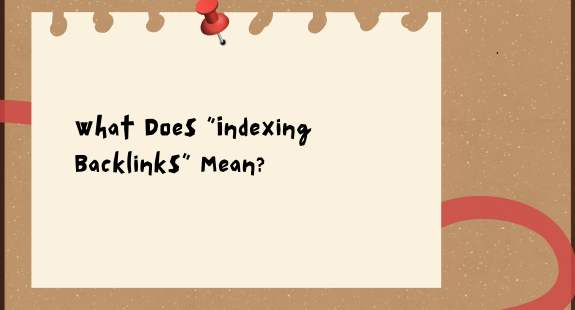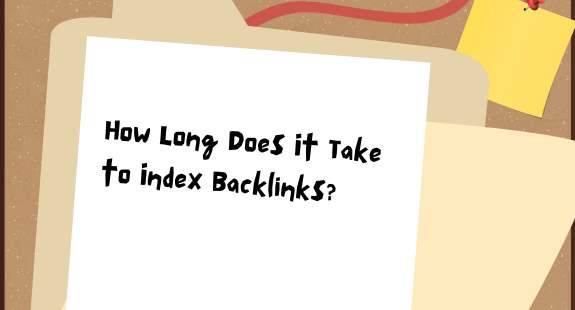Imagine this: you’ve just invested weeks in developing extraordinary back links. You’ve accomplished the whole lot right — applicable web sites, amazing anchor textual content, even a few visitor posts. But after checking Google’s index, half of of them are lacking.
Here’s the tough reality: a one way link that isn’t indexed is sort of a billboard hidden within the desert — it exists, however nobody will ever see it.
That’s why getting to know a way to index backlinks is a skill each search engine optimization expert, blogger, and business proprietor should grasp. The faster your back-links get indexed, the sooner they begin passing authority, enhancing your scores, and bringing in traffic.
In this manual, we’ll explore safe, powerful, and penalty-free approaches to index inbound links quicker.
What Does “Indexing Backlinks” Mean?

When you create a inbound link — whether or not it’s from a blog, a directory, or a visitor publish — it’s simply a bit of content material on the net. For Google to “count” it, two matters have to manifest:
- Crawling – Googlebot (or another seek engine crawler) visits the page containing your inbound link.
- Indexing – Google makes a decision to feature that web page to its searchable database.
Only after indexing can your one way link influence rankings.
Example: If you posted a visitor submit on a excessive-authority blog the day before today, Google may additionally crawl it inside hours however index it days later — or occasionally, on no account.
Why Some Backlinks Don’t Get Indexed
Knowing why one way links stay unindexed helps you avoid losing effort and time on low-fee hyperlinks.
- Low-quality pages – Thin content or unsolicited mail-crammed pages get omitted.
- Duplicate content material – Pages copied from some other place may be skipped.
- No index tags – HTML meta tags or robots.Txt may additionally block indexing.
- Low authority domain names – Google prioritizes famous, depended on websites.
- Over-optimized links – Looks unnatural and triggers suspicion.
- Nofollow attribute – Google may additionally select to move slowly however not index.
How to Index Backlinks Quickly Without Getting Penalized

The following are tried and tested methods that will help you get your backlinks recognized and indexed more quickly.
1. Submit the Backlink URL in Google Search Console
Google Search Console is the legit, hazard-loose manner to request indexing.
Steps:
- Open Google Search Console.
- Use the URL Inspection Tool.
- Paste the URL wherein your back-link is placed.
- Click Request Indexing.
Pro Tip: This works best for editorial back links from authentic web sites, not spammy directories.
2. Use Internal Linking on the Linking Website
If your back-link is inside an editorial you wrote (visitor publish, weblog publish), ask the website online owner to link that page to different properly-listed pages on their web page.
Why it really works: Google’s crawlers find out new pages faster when they’re connected to pages already inside the index.
Example: If your guest submit is linked from the website’s homepage, it will probably get indexed inside days.
3. Build Tier 2 Backlinks
This is one of the only strategies in a way to index inbound links.
What it means:
- Your back-link = Tier 1 hyperlink.
- You create extra back-links (Tier 2) pointing to the page containing your Tier 1 oneway link.
Tier 2 link sources:
- Web 2.Zero blogs (Medium, WordPress.Com)
- Social bookmarking websites
- Niche-associated boards
The extra “roads” that cause your oneway link, the less complicated it is for Google to discover it.
4. Share Backlinks on Social Media
Even though most social media links are nofollow, they’re crawled continuously.
Best structures for inbound link indexing:
- Twitter/X – Fastest indexing effects.
- LinkedIn – Especially for B2B back-links.
- Facebook Pages – Gets crawled regularly.
- Pinterest – Good for photo-wealthy content.
Example: Post the back link URL with some engaging context instead of simply dropping a uncooked link.
5. Ping the URL
Pinging tells serps, “Hey, there’s new content right here!”
Safe pinging gear:
- Pingomatic – Free, brief ping carrier.
- IndexNow – Supported with the aid of Bing, Yandex, and now partly Google.
Warning: Don’t ping again and again; a few times is enough. Over-pinging appears spammy.
6. Use Trusted Indexing Tools
Some equipment use APIs and content feeds to get Google’s interest quicker.
Popular (and more secure) indexing offerings:
- Omega Indexer – Affordable and powerful.
- LinkCentaur – Simple interface, short effects.
- Google Indexing API – Only for sure content material types (like task postings).
Always select authentic services. Black-hat indexers can cause Google consequences.
7. Leverage Blog Comments and Q&A Sites
If you leave significant comments on high-authority blogs (or submit answers on Quora/Reddit) linking in your inbound link URL, Google may additionally discover it faster.
Tip: Don’t unsolicited mail. Keep your remarks applicable and useful.
Advertisement related article:-
- Full Page Magazine Advertisement
- Bathroom Advertising
- box convenience store advertising idea
- 90s advertising slogans Indian brand with Industries
- What is Commercial Advertising
- What is an Advertiser?
How Long Does It Take to Index Backlinks?

The time frame varies:
- High-authority web sites – 24 hours to every week.
- Medium authority blogs – 7 to 14 days.
- Low authority or new websites – Weeks or in no way.
The quickest indexing I’ve seen become underneath 6 hours — however that changed into from a back-link on a famous news site.
Mistakes to Avoid When Indexing Backlinks
Using link farms – They might also get indexed however harm your ratings.
Indexing every link – Focus on satisfactory links most effective.
Over-pinging – Sends unsolicited mail signals.
Paying for shady offerings – Many promise “instantaneous indexing” but danger penalties.
Pro Tools & Resources for Backlink Indexing
| Tool / Service | Type | Pros | Cons | Price |
| Google Search Console | Free | 100% safe, direct from Google | Manual process | Free |
| Omega Indexer | Paid | Fast indexing, safe | Subscription needed | From $15/mo |
| Pingomatic | Free | Easy pinging | Limited features | Free |
| LinkCentaur | Paid | User-friendly, bulk indexing | Not instant | From $12/mo |
| IndexNow | Free | Bing + Google-supported | Not always 100% effective | Free |
Read more SEO articles:-
- SEO Strategist
- SEO for Plumbers
- Local SEO for Dentists
- SEO for Doctors
- SEO for Accountants
- SEO for Electricians
- SEO for Restaurants
- Electrician SEO
FAQs About How to Index Backlinks

Q1: Can I force Google to index backlinks instantly?
No — you could only accelerate the system. Google has the very last say.
Q2: Should I index nofollow backlinks?
Yes, for site visitors functions. They may also assist with faster crawling of your site.
Q3: What’s the safest method for beginners?
Google Search Console + social sharing.
Q4: Is tiered link building safe?
Yes, if finished with great, relevant websites.
Conclusion
Use secure techniques like Google Search Console submissions, tiered linking, social sharing, and low pinging to hurry up indexing whilst staying in Google’s excellent books.
Remember — indexing is simply the first step. The actual intention is to construct awesome inbound links that live listed and maintain to pressure site visitors for months or years yet to come.